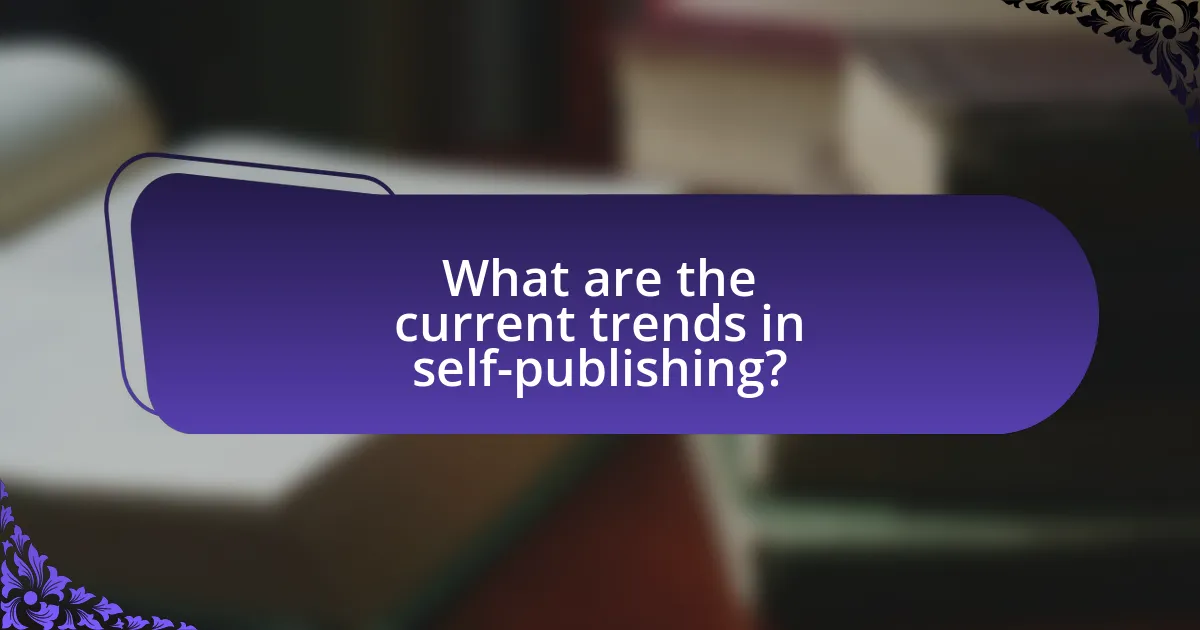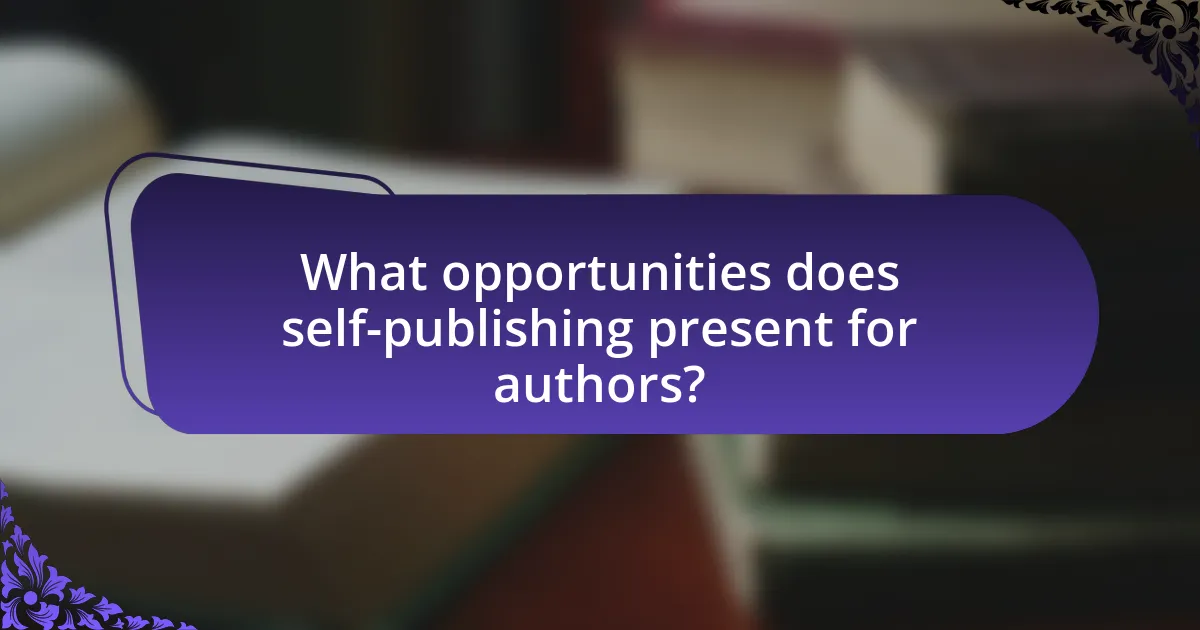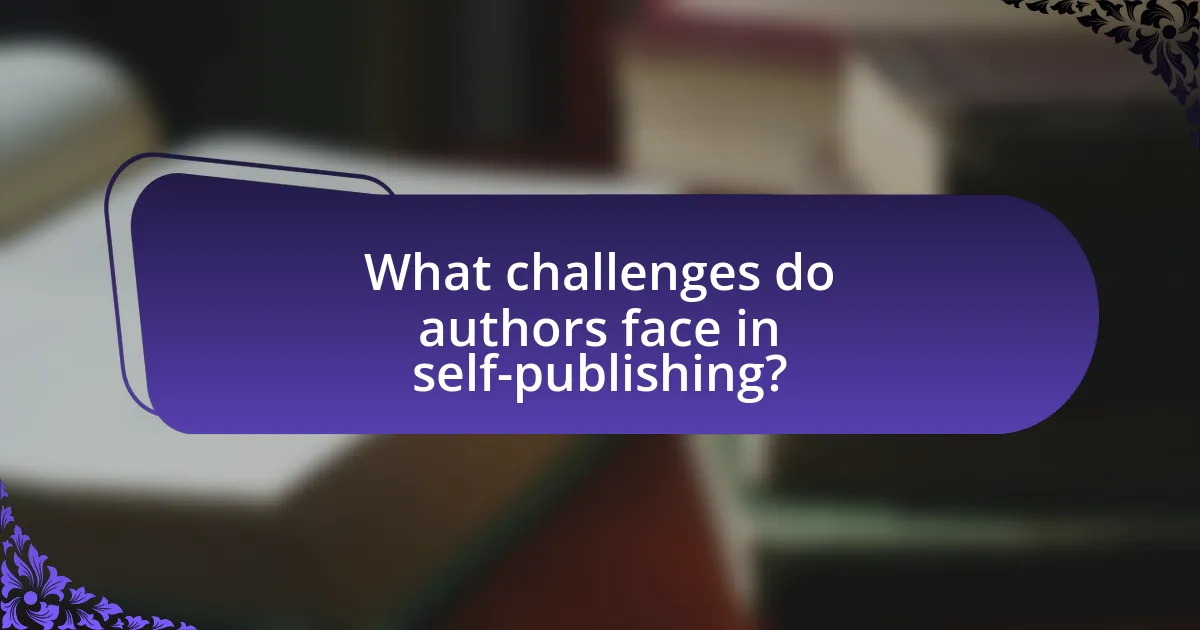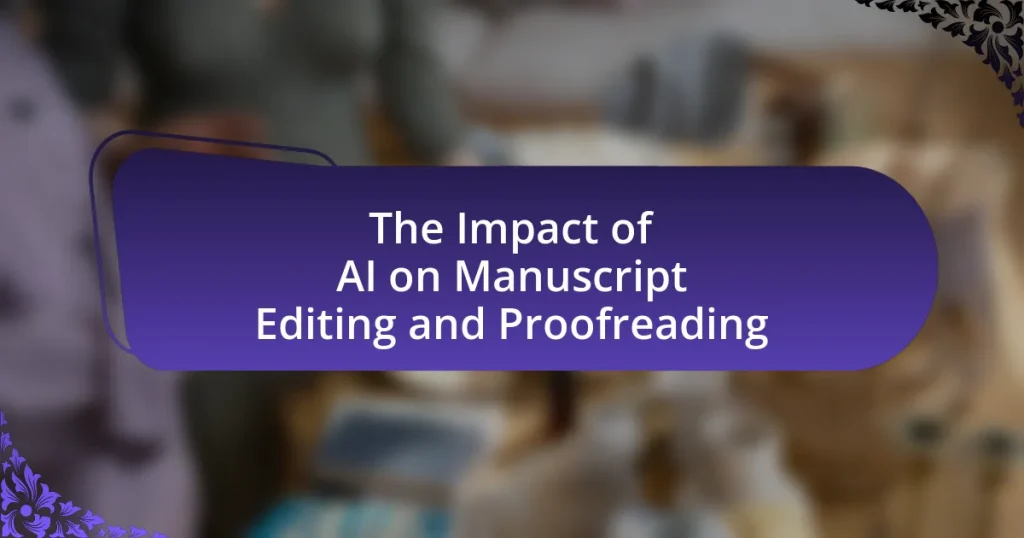The article focuses on current trends in self-publishing, highlighting the rise of hybrid publishing models, the importance of digital marketing strategies, and the growing popularity of niche genres. It examines how technology has transformed the self-publishing landscape, with platforms like Amazon Kindle Direct Publishing leading the way. Additionally, the article discusses demographic shifts, emerging genres, and the financial benefits of self-publishing, while also addressing the challenges authors face, such as marketing and distribution. Overall, it provides a comprehensive overview of the opportunities and obstacles within the self-publishing industry.

What are the current trends in self-publishing?
Current trends in self-publishing include the rise of hybrid publishing models, increased use of digital marketing strategies, and a focus on niche genres. Hybrid publishing combines elements of traditional and self-publishing, allowing authors to retain more control while benefiting from professional services. Digital marketing strategies, such as social media promotion and email newsletters, are increasingly essential for authors to reach their target audiences effectively. Additionally, the popularity of niche genres, such as self-help and specific subgenres of fiction, has grown, reflecting readers’ diverse interests and the ability of self-published authors to cater to these specific markets. According to a 2022 report by the Alliance of Independent Authors, self-published authors are increasingly leveraging these trends to enhance their visibility and sales in a competitive landscape.
How has technology influenced self-publishing trends?
Technology has significantly influenced self-publishing trends by providing authors with accessible platforms and tools for publishing their work. The rise of digital platforms such as Amazon Kindle Direct Publishing and Smashwords has enabled authors to bypass traditional publishing gatekeepers, allowing for greater creative control and faster publication timelines. According to a 2021 report by the Independent Book Publishers Association, self-published titles accounted for over 30% of the U.S. book market, highlighting the growing acceptance and prevalence of self-publishing. Additionally, advancements in print-on-demand technology have reduced upfront costs, making it financially feasible for more authors to publish their works. These technological developments have democratized the publishing landscape, empowering authors to reach global audiences without the need for traditional publishing contracts.
What digital platforms are most popular among self-published authors?
Amazon Kindle Direct Publishing (KDP) is the most popular digital platform among self-published authors. KDP allows authors to publish eBooks and paperbacks for free, reaching millions of readers through Amazon’s extensive marketplace. According to a 2021 survey by the Alliance of Independent Authors, over 80% of self-published authors reported using Amazon KDP as their primary platform, highlighting its dominance in the self-publishing industry. Other notable platforms include Smashwords and Draft2Digital, which provide distribution to multiple retailers, but KDP remains the leading choice due to its vast audience and user-friendly interface.
How do social media trends impact self-publishing success?
Social media trends significantly impact self-publishing success by enhancing visibility and audience engagement. Authors who leverage platforms like Instagram, Twitter, and TikTok can reach wider audiences, as these platforms facilitate direct interaction with potential readers. For instance, a study by the Pew Research Center indicates that 69% of adults in the U.S. use social media, providing a vast pool for authors to promote their work. Additionally, viral trends can lead to increased book sales; for example, books that gain traction through social media challenges or hashtags often see a spike in sales, as evidenced by the success of titles like “The Midnight Library” by Matt Haig, which gained popularity through social media discussions. Thus, effectively utilizing social media trends can be a crucial factor in achieving self-publishing success.
What demographic shifts are affecting self-publishing?
Demographic shifts affecting self-publishing include the increasing participation of diverse age groups, particularly younger authors, and a rise in multicultural representation. Younger generations, particularly Millennials and Gen Z, are more inclined to self-publish due to their familiarity with digital platforms and social media, which facilitate marketing and distribution. According to a 2021 survey by the Independent Book Publishers Association, 45% of self-published authors are under 40, indicating a significant shift towards younger demographics in the industry. Additionally, the growing demand for diverse voices has led to an increase in self-publishing among authors from various cultural backgrounds, reflecting broader societal changes and a push for inclusivity in literature. This trend is supported by data from the Pew Research Center, which shows that 43% of U.S. adults believe that diverse representation in media is important, influencing authors to share their unique perspectives through self-publishing.
Which age groups are most engaged in self-publishing?
The age groups most engaged in self-publishing are typically between 30 and 50 years old. This demographic often possesses the necessary skills, life experience, and financial stability to invest in self-publishing. According to a 2021 survey by the Alliance of Independent Authors, 45% of self-published authors fall within this age range, indicating a strong trend among middle-aged individuals who are leveraging digital platforms to publish their work.
How do cultural trends influence the types of books being self-published?
Cultural trends significantly influence the types of books being self-published by shaping reader preferences and market demands. For instance, the rise of social media has led to an increased interest in genres like young adult fiction and self-help, as these categories often resonate with the values and experiences shared online. Additionally, movements such as feminism and diversity have prompted authors to explore themes related to social justice, resulting in a surge of self-published works that reflect these cultural shifts. Data from the Self-Publishing Industry Report indicates that in recent years, titles addressing contemporary social issues have seen higher sales, demonstrating a direct correlation between cultural trends and self-publishing success.
What are the emerging genres in self-publishing?
Emerging genres in self-publishing include contemporary romance, psychological thrillers, and diverse narratives. Contemporary romance has gained popularity due to its relatable themes and strong character development, appealing to a broad audience. Psychological thrillers are on the rise as readers seek complex plots and unexpected twists, often reflecting societal anxieties. Additionally, diverse narratives that explore underrepresented voices and experiences are increasingly sought after, as they resonate with readers looking for authenticity and representation in literature. According to a 2022 report by the Independent Book Publishers Association, these genres have seen significant growth in sales, indicating a shift in reader preferences towards more varied and inclusive storytelling.
Which genres are seeing the most growth in self-publishing?
Romance and fantasy genres are seeing the most growth in self-publishing. According to a 2023 report by the Alliance of Independent Authors, romance titles accounted for over 30% of self-published books, while fantasy has also gained significant traction, particularly in sub-genres like urban fantasy and epic fantasy. This growth is driven by the increasing demand for diverse narratives and the ability of self-publishing platforms to reach niche audiences effectively.
How do reader preferences shape genre trends in self-publishing?
Reader preferences significantly shape genre trends in self-publishing by influencing what authors choose to write and publish. As readers express their interests through purchasing patterns, reviews, and social media engagement, authors adapt their works to align with these preferences, leading to the emergence of popular genres. For instance, the rise of romance and fantasy genres in self-publishing can be attributed to reader demand, as evidenced by data from platforms like Amazon Kindle Direct Publishing, which shows these genres consistently rank among the bestsellers. This dynamic interaction between reader preferences and author output creates a feedback loop that drives genre evolution in the self-publishing landscape.

What opportunities does self-publishing present for authors?
Self-publishing presents authors with significant opportunities, including creative control, higher royalty rates, and direct access to readers. Authors can retain full ownership of their work, allowing them to make decisions about content, design, and marketing without external constraints. Additionally, self-published authors often earn royalties ranging from 35% to 70% per sale, compared to traditional publishing, which typically offers 10% to 15%. This financial incentive encourages authors to invest in their projects and engage directly with their audience through platforms like Amazon Kindle Direct Publishing and Smashwords, which facilitate easy distribution and marketing.
How can self-publishing enhance an author’s creative control?
Self-publishing enhances an author’s creative control by allowing them to make independent decisions regarding content, design, and marketing without external constraints. Unlike traditional publishing, where publishers often dictate changes to manuscripts, cover art, and promotional strategies, self-publishing empowers authors to maintain their original vision and voice throughout the entire process. This autonomy is supported by the rise of digital platforms, which provide authors with the tools to publish and distribute their work directly to readers, thereby eliminating the need for intermediaries. As a result, authors can experiment with unconventional ideas and formats, leading to a more authentic representation of their creative intent.
What aspects of the publishing process can authors control?
Authors can control several aspects of the publishing process, including content creation, cover design, pricing, and marketing strategies. By writing their own manuscripts, authors determine the narrative, style, and themes presented in their work. Additionally, they can choose the visual elements of their book, such as the cover design, which significantly impacts reader attraction. Authors also have the authority to set their book’s price, allowing them to position their work competitively in the market. Furthermore, they can develop and implement marketing strategies, utilizing social media, email newsletters, and promotional events to reach their target audience effectively. These elements are crucial for authors in the self-publishing landscape, where they retain creative and financial control over their work.
How does creative freedom impact an author’s work?
Creative freedom significantly enhances an author’s work by allowing for unrestricted expression and innovation. When authors have the liberty to explore diverse themes, styles, and narratives, they can produce more authentic and original content. This autonomy often leads to a deeper connection with readers, as the work reflects the author’s true voice and vision. Research indicates that authors who embrace creative freedom tend to experience higher levels of satisfaction and engagement in their writing process, which can result in more compelling and impactful literature. For instance, a study published in the Journal of Creative Behavior found that creative autonomy is positively correlated with the quality of artistic output, demonstrating that when authors feel free to express themselves, their work resonates more profoundly with audiences.
What financial benefits can authors gain from self-publishing?
Authors can gain significant financial benefits from self-publishing, primarily through higher royalty rates and direct control over pricing. Unlike traditional publishing, where authors typically receive 10-15% royalties, self-published authors can earn 60-70% of the sales price on platforms like Amazon Kindle Direct Publishing. This higher percentage allows authors to retain more profit per book sold. Additionally, self-publishing eliminates the need for intermediaries, enabling authors to set their own prices and run promotions, which can lead to increased sales volume. According to a 2021 survey by the Alliance of Independent Authors, self-published authors reported an average income of $10,000 annually, showcasing the potential for substantial earnings in this model.
How do royalty rates compare between traditional and self-publishing?
Royalty rates for self-publishing typically range from 60% to 70% of the book’s sale price, while traditional publishing offers rates between 10% and 15%. This significant difference arises because self-published authors retain more control over their pricing and distribution, allowing them to earn a higher percentage per sale. In contrast, traditional publishers take a larger share to cover costs such as editing, marketing, and distribution. For example, a self-published eBook priced at $10 could yield $6 to $7 for the author, whereas a traditionally published book at the same price might only provide $1 to $1.50 in royalties.
What are the potential earnings for successful self-published authors?
Successful self-published authors can earn anywhere from $1,000 to over $100,000 annually, depending on factors such as book sales, marketing strategies, and genre popularity. According to a 2021 survey by the Alliance of Independent Authors, 30% of self-published authors reported earnings of $5,000 or more per year, while a small percentage achieved six-figure incomes. Additionally, the average self-published book sells around 250 copies in its lifetime, but successful authors often leverage multiple titles and effective marketing to significantly increase their earnings.
How does self-publishing facilitate niche marketing?
Self-publishing facilitates niche marketing by allowing authors to target specific audiences with tailored content. This approach enables writers to create specialized works that cater to unique interests, such as genre-specific novels or instructional guides on niche topics. According to a 2021 survey by the Independent Book Publishers Association, 70% of self-published authors reported that they successfully reached their target audience through focused marketing strategies. By leveraging platforms like Amazon Kindle Direct Publishing and social media, authors can directly engage with their niche markets, enhancing visibility and sales potential.
What strategies can authors use to target niche audiences?
Authors can target niche audiences by conducting thorough market research to identify specific interests and demographics. This research allows authors to tailor their content, marketing strategies, and distribution channels to meet the unique needs of their audience. For instance, utilizing social media platforms like Facebook and Instagram enables authors to engage directly with niche communities, fostering a sense of connection and loyalty. Additionally, authors can leverage targeted advertising, such as Facebook Ads, which allows for precise audience segmentation based on interests, behaviors, and demographics. According to a 2021 report by Statista, 54% of marketers found that targeted ads significantly improved their engagement rates, highlighting the effectiveness of this strategy. By focusing on these methods, authors can effectively reach and resonate with their niche audiences.
How does understanding niche markets affect book sales?
Understanding niche markets significantly enhances book sales by allowing authors to target specific audiences with tailored content. When authors identify and cater to niche markets, they can create books that resonate deeply with particular reader interests, leading to higher engagement and sales. For instance, a study by the Pew Research Center indicates that niche genres, such as self-help or specific historical fiction, often see increased sales due to dedicated readerships that actively seek out these specialized topics. This targeted approach not only improves visibility in crowded markets but also fosters community among readers, further driving sales through word-of-mouth and recommendations.

What challenges do authors face in self-publishing?
Authors face several challenges in self-publishing, including marketing, distribution, and quality control. Marketing is particularly difficult as authors must compete with established publishers and navigate the complexities of online promotion without the support of a marketing team. Distribution poses another challenge, as authors need to understand various platforms and formats to reach their audience effectively. Quality control is also critical; authors must ensure their work is professionally edited and formatted, which often requires additional investment. According to a 2021 survey by the Alliance of Independent Authors, 70% of self-published authors reported that marketing was their biggest hurdle, highlighting the significant challenges they encounter in this landscape.
What are the common pitfalls of self-publishing?
The common pitfalls of self-publishing include inadequate editing, poor marketing strategies, and lack of professional design. Inadequate editing often leads to subpar content, which can result in negative reviews and reduced sales; studies show that 70% of self-published authors report that editing is a critical factor in their book’s success. Poor marketing strategies can leave a book unnoticed in a saturated market, as self-published authors frequently lack the resources or knowledge to effectively promote their work. Additionally, lack of professional design, including cover art and formatting, can diminish a book’s appeal, with research indicating that 75% of readers judge a book by its cover. These pitfalls can significantly hinder an author’s ability to succeed in the self-publishing landscape.
How can authors avoid mistakes in the self-publishing process?
Authors can avoid mistakes in the self-publishing process by thoroughly researching the publishing landscape and understanding the necessary steps involved. This includes familiarizing themselves with formatting requirements, cover design, and distribution channels. For instance, a study by the Alliance of Independent Authors indicates that authors who invest in professional editing and cover design significantly increase their chances of success, as these elements directly impact reader perception and sales. Additionally, authors should create a marketing plan prior to publication, as effective promotion is crucial for visibility in a crowded market.
What are the consequences of poor marketing strategies?
Poor marketing strategies can lead to significant financial losses for authors in self-publishing. When marketing efforts fail to reach the target audience or effectively communicate the book’s value, sales can plummet, resulting in a lack of revenue. According to a survey by the Alliance of Independent Authors, 70% of self-published authors reported that inadequate marketing was a primary reason for low book sales. Additionally, poor marketing can damage an author’s reputation, as negative perceptions can arise from ineffective promotional tactics, leading to long-term consequences for future works.
How does competition impact self-published authors?
Competition significantly impacts self-published authors by influencing their visibility and sales potential. In a saturated market, self-published authors must differentiate their work through quality, marketing strategies, and unique branding to attract readers. According to a 2021 survey by the Alliance of Independent Authors, 70% of self-published authors reported that competition from other self-published works made it more challenging to gain visibility. This competition can drive authors to improve their writing and marketing efforts, ultimately leading to higher quality content in the self-publishing industry.
What strategies can authors employ to stand out in a crowded market?
Authors can stand out in a crowded market by developing a unique brand identity and leveraging targeted marketing strategies. Establishing a distinct voice and visual style helps authors differentiate themselves from competitors, while targeted marketing, such as utilizing social media platforms and email newsletters, allows them to reach specific audiences effectively. According to a 2021 survey by the Independent Book Publishers Association, 70% of successful self-published authors reported that a strong online presence significantly contributed to their visibility and sales.
How does the volume of self-published works affect visibility?
The volume of self-published works significantly affects visibility by increasing competition among titles, which can dilute individual visibility. As more authors enter the self-publishing space, the sheer number of available works makes it harder for any single title to stand out. For instance, in 2020, over 1.7 million self-published books were released, leading to a saturated market where readers face an overwhelming choice. This saturation can result in lower discoverability for new authors unless they employ effective marketing strategies or leverage platforms that enhance visibility, such as social media or targeted advertising.
What are the challenges of distribution and sales for self-published authors?
Self-published authors face significant challenges in distribution and sales, primarily due to limited access to traditional retail channels and the need for effective marketing strategies. Many self-published authors struggle to get their books into brick-and-mortar stores, as these retailers often prioritize established publishers. Additionally, self-published authors must navigate online platforms, where competition is fierce, and visibility is often dependent on marketing efforts rather than the quality of the book itself. According to a 2021 survey by the Alliance of Independent Authors, 70% of self-published authors reported that marketing their books was their biggest challenge, highlighting the necessity for authors to invest time and resources into promotional activities to drive sales.
How can authors effectively distribute their books?
Authors can effectively distribute their books by utilizing multiple channels such as online retailers, social media platforms, and direct sales through personal websites. Online retailers like Amazon and Barnes & Noble provide vast reach and established customer bases, while social media platforms enable authors to engage directly with potential readers and promote their work. Additionally, authors can enhance distribution by participating in book fairs and local events, which can create personal connections with readers. According to a 2021 survey by the Independent Book Publishers Association, 70% of authors reported that online sales were their primary distribution channel, highlighting the importance of digital platforms in modern book distribution.
What sales channels are most effective for self-published authors?
The most effective sales channels for self-published authors are online retailers, particularly Amazon, and direct sales through personal websites. Amazon dominates the self-publishing market, accounting for approximately 80% of eBook sales, which highlights its significance as a primary sales channel. Additionally, authors who sell directly through their websites can retain a higher percentage of profits and build a direct relationship with their readers, enhancing customer loyalty. Other notable channels include social media platforms for marketing and promotion, as well as print-on-demand services that allow authors to reach physical bookstores and libraries.
What best practices can authors follow to succeed in self-publishing?
Authors can succeed in self-publishing by focusing on high-quality writing, effective marketing strategies, and understanding their target audience. High-quality writing involves thorough editing and professional formatting, which enhances the book’s readability and appeal. Effective marketing strategies include building an author platform through social media, engaging with readers, and utilizing email newsletters to promote new releases. Understanding the target audience allows authors to tailor their content and marketing efforts, increasing the likelihood of sales. According to a survey by the Independent Book Publishers Association, 70% of self-published authors reported that marketing efforts significantly impacted their book sales, underscoring the importance of these practices.



